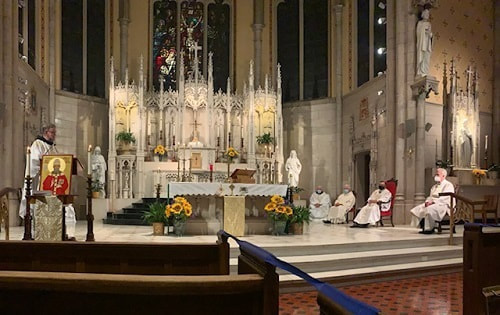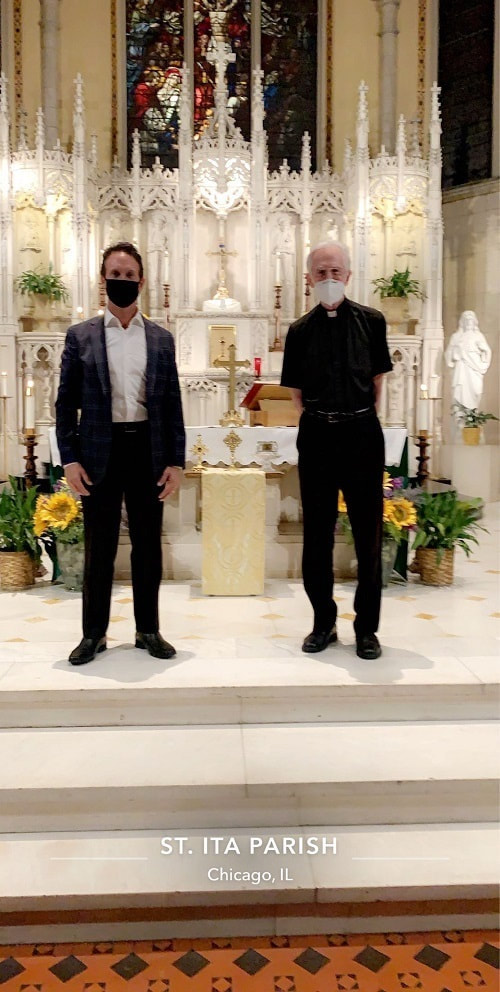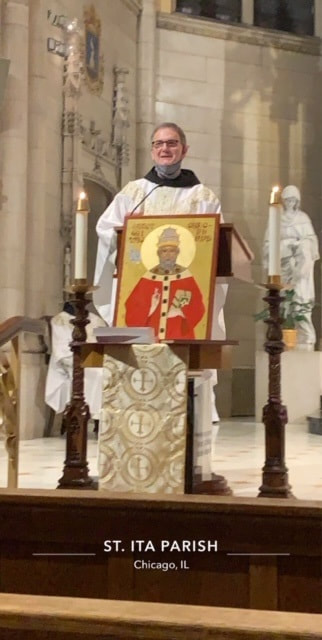"A Medieval jewel in a modern setting..." Church Architecture History
St. Gregory the Great Church has served the north side of Chicago since 1904, when the Luxembourgers of the neighborhood petitioned for the creation of a new parish. Education is at the heart of St. Greg’s — from the magnificent Norman Gothic church that teaches the faith through its stunning altars, windows and very design, to the countless graduates of its elementary and high school. Officially classified as a church in the Norman Gothic style (Norman referring to the French influence on English architecture following the Norman Conquest of England in 1066), St. Gregory's is a direct descendant of the great flowering of churches in the Medieval style that began in the early 19th Century. The movement, called Gothic Revival, began in England as a spiritual/cultural revolt against the Industrial Revolution and embraced not only architecture but art, poetry, literature and music as well. Its proponents included the author Sir Walter Scott, artist and critic John Ruskin, the designer William Morris and the architect A.W.N. Pugin. It was Pugin who truly reinvigorated the nation with the spiritual and the artistic aesthetic of the Middle Ages, and his churches and public buildings (including the Houses of Parliament) stand as some of the finest architecture of the 19th Century. St. Gregory the Great Church is one of the finest examples of Gothic Revival architecture in the Archdiocese of Chicago, and as such acts as a complete spatial instruction in the truths of the Christian faith. Everything, from the paintings and sculptures to the architecture elements itself, not only tells a story but invites us deeper into the heart of the mystery that is Christ's Church. The journey into St. Gregory's Church is a journey into life, death and re-birth, from Alpha to Omega, from darkness to light. Msgr. Michael Klasen, the founding pastor of St. Gregory the Great Church, created a booklet entitled The Church Beautiful in which he explains the symbolism and meaning of the various shrines, stained glass windows, and other liturgical decorations that can be found in our Church. Click on the following link to learn more about our Church Beautiful. In 1942, Monsignor Michael Klasen, the founding pastor of St. Gregory the Great, published the following monograph or booklet, which he entitled, “The Church Beautiful,” for the people of St. Gregory’s, sketching out the history of our beautiful church and detailing its appointments. We believe that both long-time parishioners, as well as newcomers, will find the booklet interesting and helpful in discerning the intricate meanings of the art and architecture of our singularly beautiful church.
In recent years St. Gregory’s has pursued a mission called ‘Evangelization through the Arts.” We seek to articulate the gospel of Christ in languages beyond words. This effort was first inspired by our awareness of the sublime gift that we have been given in our ‘inheritance’ of “The Church Beautiful.” In addition to truth and goodness, beauty has long been deemed one of the favored pathways to God. The beauty of our church is validation of this ancient insight. Where else, in our neighborhood or city, can one find a church where beauty is harnessed to such a noble purpose in expressing the truths of Christ’s gospel? Our ‘Artist in Residence Program’ and our perennial efforts to celebrate the beauties of the Church’s liturgical life with dignity and grace further elaborate our strategy of ‘evangelizing through the arts.’ In the text that follows, Monsignor Klasen lovingly expresses the meaning of virtually all of the artistic and architectural details of our church. Due to the sheer volume of these details, this is a text that is meant to be savored and absorbed across the course of many readings. In a number of places, we have added brief explanations of words or phrases that have been modified in church-life since the brochure was first published. Most of these changes were the result of the liturgical reforms of the Second Vatican Council (1961-1965.) Explanations that have been added are printed in italics and within parentheses. Please enjoy this treasure from our parish history. May God, who has begun the good work in us, bring it to fulfillment. Gaudete Sunday, Third Sunday of Advent, December 13, 2009 Feast Day: January 15  St. Ita, baptized Deidre, was born of a Christian family about 475 A.D. near the present city of Waterford, Ireland. She was the daughter of the chieftain Confhaola and of Necta who claimed royal descent from Feighlim Reachtmhar, King of Tara. From an early age, Deirdre was said to embody the six virtues of Irish womanhood — wisdom, purity, beauty, music, sweet speech and embroidery. She was described as “sweet and winning in her address, prudent in word and work and constant in mind and firm of purpose.” This last virtue of “being firm of purpose” stood to her when it came to making decisions about her life’s work. Her parents hoped she would marry a nobleman of another clan; Deidre wanted to serve God in religious life. To overcome her parents' resistance to her chosen path, she fasted and prayed for three days and three nights, and on the third night, God revealed a message to her father in his sleep. The next morning, Conflhaola gave Deidre his blessing to follow her calling. At the age of sixteen, Deidre received the monastic habit of a nun and took the name of Ita. The name Ita is said to come from the Irish word iota, meaning thirst for holiness. Ita then set out for Limerick, possibly in the company of her sister Fiona, who was later to become a nun in the community at Killeedy. Ita settled at Cluain Credall where there was a spring well - now a holy well - on the site of what later became a church. She turned down offers by the people and King of Ui Chonaill to take over all the lands of the area and settled instead for four small divisions of land to provide her small community with food. The initial settlement later became known as Cill Ide or Killeedy (Ita's cell) and prospered as a center of learning and spiritual formation, drawing men and women from as far away as the Midlands. Children came, too, for this was still the age of fosterage in the old Gaelic tradition. One of the most famous of her pupils is said to be St. Brendan, the Navigator or Voyager of Clonfert. Among many others, the great Saint Columban came to Ita for counsel and guidance in the problems of his apostolate. It is thought that Ita was a contemporary of Saint Patrick as well. Legend has it that Brendan asked Ita the three things which she thought God loved most. She said: "True faith in God with a pure heart, a simple life with a grateful spirit, and openhandedness to the poor inspired by charity." The three things that most displease God are: "a mouth that hates people, a heart harboring resentments and confidence in wealth." Ita's life was spent mainly at Cill Ide, and, according to Sr. Declan Power, hers was a life based on penance, asceticism, vigils, fast and prayer. She was said to have special devotion to the infant Jesus and to have sung the Irish lullaby, Losagan, to mark that special love. St. Ita, sometimes called "the white sun of the women of Munster" or the "Brigid of Munster," died on January 15, 570 A.D. and was laid to rest in her own Pobal Ide, where countless generations have come to pray. Today, the convent is marked only by broken walls and rocks worn smooth by wind and rain of centuries. Her memory remains a real force in the religious fervor of Limerick and of our parish. We celebrate her Feast Day on January 15th. Today, a hospital in Portrane, County Dublin, Ireland, a Catholic parish in Drouin, Australia and our church, the only one, as far as we know in North America, share her name. In fact, the cornerstone of this very church (on the corner of Catalpa and Broadway) contains a stone from the Monastery at Killeedy. St. Ita is revered still today as one of the great saints of Ireland. 06/25/1900 Father Crowe is appointed to establish a new congregation in Edgewater. St. Ita Parish is founded.
07/01/1900 Father Crowe celebrates the First Mass for the parish of St. Ita in the old Guild Hall. 12/25/1900 The first Mass is celebrated in the frame building of St. Ita Church. 06/09/1901 The frame Church is dedicated by Archbishop Feehan. 09/12/1901 Father Crowe moves into the frame rectory which had been built at 1220 W. Catalpa. 09/06/1904 St. Ita School opens in the basement of the Church. 04/02/1906 Ground at 5519 N. Magnolia is broken for a new school. 01/01/1909 The Sisters of Mercy, who staff the school, move into new convent next to the school building. 09/1909 All three stories of the brick school building are completed. 04/07/1924 Ground is broken for the Church of St. Ita. Architect Henry J. Schlacks's French Gothic masterpiece. 09/14/1924 The cornerstone for the new Church is laid after the old frame Church is razed. 04/17/1927 The first Mass is celebrated in the present Church. 10/09/1927 St. Ita Church is dedicated by George Cardinal Mundelein. 09/02/1930 Monsignor C.J. Quille is named pastor of St. Ita Parish. 05/02/1942 Father Gerard C. Picard is named pastor of St. Ita. 11/18/1951 Samuel Cardinal Stritch presides at the Golden Jubilee of the construction of the first Church of St. Ita Parish. 05/1968 Father Raymond J. Morrison is named pastor of St. Ita Parish. 09/21/1969 The 50th Anniversary of Monsignor Picard's Ordination is celebrated in the new Jubilee Hall. 10/12/1975 A Mass of Thanksgiving is celebrated to mark the 75th Anniversary of St. Ita Parish. 02/11/1976 Father Richard J. Feller is appointed pastor of St. Ita Parish. 09/01/1988 Father Laurence F. Maddock is appointed pastor of St. Ita Parish. 10/13/1990 St. Ita Parish celebrates its 90th Anniversary. 01/15/2000 The Centennial Year for St. Ita Parish begins with the celebration of the Feast of Saint Ita. 11/19/2000 Francis Cardinal George presides at the Centennial Mass. The new altar is dedicated and the Church is rededicated. 06/2001 Father Steven W. Patte is appointed pastor of St. Ita Parish. 02/2006 Father David P. Pavlik is appointed pastor of St. Ita Parish. 07/2012 Father JoAndre B. Beltran is appointed pastor of St. Ita Parish. 07/2016 Archdiocese entrusts parish to Conventual Franciscan Friars. Father Bob Cook, OFM Conv., is appointed first Franciscan pastor of Saint Ita Parish. 05/31/2019 St. Ita and St. Thomas of Canterbury merge and become Ss. Ita and Thomas of Canterbury Parish on the Feast of the Visitation. 09/03/2020 St. Gregory the Great is added to the parish, which is renamed Mary Mother of God, on the Feast of St. Gregory the Great. Feast Day: December 29  St. Thomas of Canterbury (1120-1170), also known as St. Thomas Becket, was an Englishman of minor Norman nobility who was the boon companion and Chancellor of King Henry II of England. Hungry for advancement and power, Thomas became close to the old Archbishop of Canterbury and was ordained Archdeacon. However, it was as the King’s Chancellor that Thomas excelled, becoming one of the most ruthlessly efficient enforcers of the King’s tax and revenue laws. When the old Archbishop died, Henry hoped to checkmate the power of the wealthy Norman bishops and abbots by making his friend and right-hand man Thomas Becket the new Archbishop. To Henry’s everlasting regret and rage, Thomas underwent a startling spiritual transformation upon being ordained a bishop and instead of rubber-stamping the King’s laws to get more wealth from a weakened English Church, he became a staunch defender of Church rights, property and honor. Thomas, although warned by the Pope to tread wisely, rigorously defended the Church and clergy against the State and soon was at odds with Henry. Threats, excommunications and more threats from all sides led to Thomas fleeing England for the continent. When he returned in 1170, he was murdered during evening Vespers in Canterbury Cathedral by four of Henry’s knights. Such was the outrage and devotion of the people to their beloved archbishop that Pope Alexander III canonized Thomas almost immediately. The icon of St. Thomas of Canterbury is by Chicago artist Joseph Malham. He is dressed in the red vestments and miter that connote martyrdom, and on his shoulder he holds a heavy broadsword (the knights killed him with swords). There is a small nick in the sword that shows the ultimate failure of the temporal City of Man to overpower the eternal City of God. On his miter are seven blood red stones representing the Seven Sacraments, and on his chasuble are twelve stones representing the Twelve Apostles. -From Joseph Malham's History of St. Thomas of Canterbury Church Feast Day: September 3 St. Gregory the Great was born around the year 540 A.D. in Italy, “into a world in which peace and stability could not be taken for granted.” (R.A. Markus, Gregory the Great and His World) He was named the Prefect of Rome in either his late 20s or early 30s, but resigned the office and entered monastic life around the year 575, converting his family home into a monastery dedicated to St. Andrew. Despite becoming a monk, Gregory soon afterwards was ordained a deacon and then sent to Constantinople as the representative of Pope Pelagius II in 579. He was recalled to Rome around 585 or 586 and returned to his monastery. In 590, he was elected Pope, succeeding Pelagius II. Over the course of his papacy, Gregory worked to keep Rome secure against the Lombard tribes that had invaded Italy, buying temporary truces with them, negotiating treaties and ransoming prisoners, and providing for the poor amid famines and plagues. He also wrote Pastoral Care in 590, a treatise on the responsibilities of bishops that has remained influential in the centuries since its publication. In this work, Gregory calls on bishops to maintain a life of prayer while diligently attending to the needs of those entrusted to their care. In 597, he launched a mission for the conversion of England, sending a mission of 40 monks, including some from his own monastery. When Catholicism eventually took root in England, the church there would regard Gregory as a founding father. His favorite title for the papacy was “servant of the servants of God.” St. Gregory the Great is a Doctor of the Church, one of the four Great Latin Fathers. The others are St. Ambrose, St. Augustine and St. Jerome, and all four are featured on the high altar of St. Gregory church (pictured above). Pope St. Gregory the Great is the figure located at the far right. Sources: Eamon Duffy, Saints & Sinners: A History of the Popes R.A. Markus, Gregory the Great and His World Mass celebrating the unification of St. Gregory the Great with Ss. Ita and Thomas of Canterbury Parish. Bishop Robert Casey presided.
|
If you would like to share an announcement (i.e. funeral, Sacrament, anniversary, etc.) with the parish community, please email the parish office. Archives
July 2024
Categories
All
|






